Did you know that Green Zebra tomatoes, with their visually appealing stripes and sweet yet tart taste, have been a favorite among chefs and home gardeners for years? These unique tomatoes offer a burst of flavor to salads and salsas, making them a must-have addition to any organic harvest. But how can you successfully grow these vibrant fruits in your own backyard?
Key Takeaways:
- Green Zebra tomatoes are a visually appealing and flavorful variety.
- They require well-drained soil, at least six hours of sunlight, and regular irrigation.
- These tomatoes can be harvested in 75 to 80 days from transplant.
- With proper care, you can grow organic Green Zebra tomatoes in your own backyard garden.
- Follow our tips to ensure a successful harvest of these unique and delicious tomatoes.
Characteristics of Green Zebra Tomatoes
Green Zebra tomatoes are a unique variety known for their visual appeal and distinct flavor. These tomatoes are characterized by their vibrant green color and dark stripes, which give them a striking appearance. As the tomatoes mature, they transition from green to a beautiful chartreuse green-yellow hue with mottled green and orange stripes, creating a feast for the eyes.
Unlike traditional red tomatoes, Green Zebra tomatoes are relatively small in size, making them perfect for snacking or adding to salads and salsas. Their petite size also makes them great for garnishing dishes or creating visually stunning presentations.
One of the standout features of Green Zebra tomatoes is their sweet and tart taste. These tomatoes offer a burst of flavor that is both refreshing and exciting. The combination of sweetness and tartness creates a delightful balance that appeals to the taste buds.
Whether you’re a gardener looking to add a unique touch to your backyard garden or a chef looking to elevate your culinary creations, Green Zebra tomatoes are a must-have. Their distinct appearance, small fruit size, and sweet and tart taste make them a versatile ingredient that adds a touch of novelty and excitement to any dish.
| Characteristics | Description |
|---|---|
| Color | Green with dark stripes, transitioning to chartreuse green-yellow with mottled green and orange stripes |
| Size | Relatively small, perfect for snacking and garnishing |
| Taste | Sweet and tart, providing a burst of flavor |
Growing Requirements for Green Zebra Tomatoes
To successfully grow Green Zebra tomatoes, it’s important to provide them with the right growing conditions. These tomato plants thrive in well-drained soil, free of weeds and other obstructions, to ensure proper root development and prevent waterlogging. The soil should be loose and crumbly, allowing for excellent drainage.
Sunlight is another crucial factor in the successful cultivation of Green Zebra tomatoes. These plants require at least six hours of direct sunlight per day to thrive. Choose a sunny spot in your garden or yard to plant them, ensuring they are not shaded by tall trees or structures.
Irrigation is essential for the healthy growth of Green Zebra tomatoes. Tomato plants typically require about an inch of water per week, either from rainfall or supplemental irrigation. Regularly check the soil moisture level and water the plants deeply when the top inch of soil feels dry. Avoid overwatering, as it can lead to root rot and other fungal diseases.
When it comes to fertilization, organic options work best for Green Zebra tomatoes. Apply a well-balanced organic fertilizer, following the package instructions for application rates and frequencies. Organic fertilizers provide essential nutrients to the plants and improve soil health, resulting in vigorous growth and flavorful fruit.
To support the indeterminate growth habit of Green Zebra tomatoes, it’s crucial to provide adequate support. Indeterminate tomatoes continually grow and produce fruit throughout the growing season, reaching heights of up to five feet or more. Sturdy stakes, tomato cages, or trellises can be used to support the vines and prevent them from sprawling on the ground. Supporting the plants also facilitates proper air circulation and reduces the risk of diseases.
Remember to prepare the soil, provide sufficient sunlight and water, nourish with organic fertilizer, and support the tomato plants for a successful harvest of flavorful Green Zebra tomatoes.
| Requirements | Details |
|---|---|
| Soil | Well-drained, weed-free soil |
| Sunlight | At least six hours of direct sunlight per day |
| Irrigation | Approximately one inch of water per week |
| Organic Fertilizer | Apply a well-balanced organic fertilizer according to package instructions |
| Supports | Sturdy stakes, tomato cages, or trellises to support the vines |
Starting Green Zebra Tomatoes from Seed
When it comes to growing Green Zebra tomatoes, you have two options: starting from seed or purchasing seedlings. If you’re up for the challenge and want to experience the excitement of seeing your plants grow from the very beginning, starting from seed is the way to go. Here’s a step-by-step guide on how to get started.
1. Timing your planting
Timing is crucial when starting Green Zebra tomatoes from seed. You want to make sure that the seedlings are ready to be transplanted outdoors after the last frost date in your area. Depending on your location, this may vary. To determine the best time to plant, consult a local gardening resource or use an online frost date calculator.
2. Sourcing your seeds
You can find Green Zebra tomato seeds at various nurseries or farmers’ markets, or you can order them online from reputable seed suppliers. Make sure to choose organic seeds for a healthy and sustainable harvest.
3. Planting your seeds
Planting Green Zebra tomato seeds is a straightforward process. Fill seed trays or small pots with seed-starting mix, and sow the seeds according to the instructions on the seed packet. Cover the seeds lightly with soil, and gently water them.
Remember, Green Zebra tomatoes have a relatively long germination period, typically ranging from 7 to 14 days. Be patient and keep the soil moist during this time.
4. Providing the right conditions
For successful seed germination, Green Zebra tomatoes require warmth and consistent moisture. Place the seed trays or pots in a warm area with temperatures between 70°F and 80°F (21°C and 27°C), such as near a sunny window or under a grow light.
Continue to water the seeds gently to keep the soil evenly moist, but not waterlogged. Avoid overwatering, as it can lead to seed rot or fungal diseases.
5. Transplanting outdoors
Once the seedlings have grown their second set of true leaves and the danger of frost has passed, they are ready to be transplanted outdoors. This usually occurs in the spring, when temperatures are consistently above freezing and the soil has warmed up.
Choose a sunny spot in your garden, with at least six hours of direct sunlight per day. Prepare the soil by removing weeds and incorporating organic matter, such as compost, to improve drainage and fertility.
When planting the seedlings, make sure to dig a hole deep enough so that the crown of the plant, where the stem meets the roots, is buried about 2 to 3 inches (5 to 8 cm) below the soil surface. This will encourage stronger root development and a more stable plant.
6. Growing in containers
If you don’t have a suitable garden space, don’t worry! Green Zebra tomatoes can also be grown in containers. Choose a container that is at least 18 inches (45 cm) in diameter and has drainage holes to prevent waterlogging.
Fill the container with well-draining potting mix and plant the seedlings as described above. Make sure the container is placed in a sunny area and provide supports, such as a tomato cage or stakes, to keep the plants upright as they grow.
| Pros of starting from seed | Cons of starting from seed |
|---|---|
| Opportunity to witness the entire growth process from seed to harvest | Requires more time and effort compared to purchasing seedlings |
| Access to a wider variety of tomato cultivars | Requires investing in seed-starting equipment and supplies |
| Potential cost savings compared to buying seedlings | Seedlings may be more resilient to environmental stress |
Care and Maintenance for Green Zebra Tomato Plants
Proper care and maintenance are essential for the growth and productivity of Green Zebra tomato plants. By following these tips, you can ensure your plants thrive and produce a bountiful harvest.
Sunlight
Green Zebra tomato plants thrive in sunny locations and require at least six hours of direct sunlight per day. Place them in a spot where they can soak up the sun’s rays to promote healthy growth and fruit development.
Soil
The soil for Green Zebra tomatoes should be rich, sandy, and well-drained. It should also have a slightly acidic pH level. Prepare the soil by incorporating organic matter, such as compost, to improve its fertility and drainage.
Watering
Regular watering is crucial, especially once the plants start flowering and bearing fruit. Water the plants at the base to avoid wetting the foliage, which can lead to mold or mildew. Be sure not to overwater, as it can cause root rot. Aim to keep the soil consistently moist, but not waterlogged.
Temperature
Green Zebra tomato plants prefer warm weather, with optimal temperatures ranging between 50 and 75°F (10 to 24°C). Provide adequate protection from extreme heat or cold to prevent stress on the plants.
Fertilizer
Fertilizing the plants with a low nitrogen 5-10-10 fertilizer will help promote fruit development and ripening. Apply the fertilizer according to the instructions on the package and avoid over-fertilization, as it can lead to excessive foliage growth at the expense of fruit production.
Ripening
Green Zebra tomatoes start to ripen when they develop yellow or orange hues and can be gently pulled off the vine. Harvest them as they reach the desired level of ripeness to savor their unique flavor and enjoy them in a variety of recipes.
| Care Tips | Considerations |
|---|---|
| Ensure at least six hours of direct sunlight per day | |
| Use well-drained, sandy soil with a slightly acidic pH | |
| Water at the base of the plant to prevent mold or mildew | |
| Provide protection from extreme temperature fluctuations | |
| Fertilize with a low nitrogen 5-10-10 fertilizer | |
| Harvest tomatoes when they reach the desired ripeness |
Remember to monitor your Green Zebra tomato plants regularly for signs of any issues, such as pests or diseases, and take prompt action to address them. With proper care and maintenance, you’ll be rewarded with a delicious harvest of flavorful and visually striking tomatoes.
Growing Green Zebra Tomatoes in Containers
Container gardening offers a convenient and space-efficient way to grow Green Zebra tomatoes. By choosing the right container size, providing adequate sunlight and support, and ensuring proper watering and fertilization, you can enjoy a bountiful harvest of these flavorful tomatoes right on your patio or balcony.
Choosing the Right Container Size
When selecting a container for your Green Zebra tomatoes, opt for one that is large enough to accommodate the roots of the plants. A half wine barrel or a similarly sized ceramic or resin container would be suitable. This allows the roots to spread and promotes healthy growth.
Ensuring Adequate Sunlight and Support
Place your container in a sunny location where the tomatoes will receive at least six hours of direct sunlight each day. This is crucial for their growth and fruit production. Additionally, provide support for the tomato plants to keep them upright as they grow. Staking or putting up a trellis will prevent the plants from sprawling and maximize space usage.
Watering and Fertilization
Container-grown tomatoes may require more frequent watering compared to those grown in the ground, as the soil tends to dry out more quickly. Monitor the moisture level of the soil and water thoroughly whenever it feels dry about an inch below the surface. Remember to water at the base of the plant to prevent splashing soil onto the leaves.
Fertilizing regularly is essential for the optimal growth and development of your Green Zebra tomatoes. Use a water-soluble fertilizer specifically formulated for tomatoes and follow the instructions for application rates. This will provide the necessary nutrients for healthy plant growth and flavorful fruit.
| Container Gardening Tips for Green Zebra Tomatoes |
|---|
| Choose a container large enough to accommodate the roots of the plants. |
| Place the container in a sunny location with at least six hours of direct sunlight per day. |
| Provide support for the tomato plants to keep them upright as they grow. |
| Water the plants regularly, ensuring the soil doesn’t dry out completely. |
| Fertilize with a water-soluble fertilizer formulated for tomatoes to provide essential nutrients. |
By following these container gardening tips, you can enjoy the satisfaction of growing delicious Green Zebra tomatoes, regardless of limited gardening space. With proper care and attention, your container-grown tomatoes will thrive and reward you with a vibrant and abundant harvest.
Pruning and Disease Prevention for Green Zebra Tomato Plants
Proper pruning techniques and disease prevention strategies are essential for maintaining healthy Green Zebra tomato plants and ensuring a bountiful harvest. Pruning plays a crucial role in promoting optimal growth and larger fruit size. By removing any yellowed, wilting, or damaged leaves and stems, you can redirect the plant’s energy towards healthy growth.
To prevent the spread of mold and mildew, it’s important to thin out the lower six inches of the stem. This allows for better airflow and reduces the risk of moisture buildup. Additionally, light pruning can be necessary to allow sufficient sunlight to reach the tomatoes, aiding in the ripening process.
Tomato Diseases and Pests
While Green Zebra tomatoes are naturally resistant to some common tomato diseases, it’s crucial to remain vigilant as they can still be susceptible to certain issues such as wilt, blight, and mosaic virus. Regularly inspect the plants for signs of disease, including yellowing leaves, brown spots, or wilting, and take appropriate action if necessary.
Pests pose another potential threat to your tomatoes. Common culprits include aphids and wildlife that may attack the plants or eat the fruit. To protect your Green Zebra tomatoes, consider using netting or other suitable measures to safeguard against these pests.
| Disease | Signs and Symptoms | Prevention |
|---|---|---|
| Wilt | Wilting leaves, stunted growth, yellowing | Choose disease-resistant varieties, rotate crops, practice proper sanitation |
| Blight | Brown spots on leaves, fruit rot | Keep foliage dry, provide adequate spacing, promote good airflow |
| Mosaic Virus | Mottled or distorted leaves, stunted growth | Control aphids or other potential carriers, remove infected plants |
Remember, prevention is key when it comes to tomato diseases and pests. Regularly inspect your plants, practice proper sanitation, and take timely action to minimize potential damage.
In the next section, I’ll share some common issues you may encounter with Green Zebra tomato plants and provide solutions to help you address them effectively.
Common Issues and Solutions for Green Zebra Tomato Plants
Green Zebra tomato plants, like any other garden plants, can face various issues that can negatively affect their growth and fruit production. However, with proper care and attention, these problems can be addressed effectively. Here are some common issues that tomato plants may encounter, along with their solutions:
Blossom End Rot
One common problem faced by Green Zebra tomato plants is blossom end rot. This issue manifests as black spots or a dark, leathery area on the bottom of the tomato fruit. Blossom end rot is typically caused by a calcium deficiency in the soil.
To prevent blossom end rot in Green Zebra tomatoes, it’s important to ensure that the plants receive an adequate supply of calcium. One effective way to do this is by adding crushed eggshells to the soil before planting. Eggshells are a natural source of calcium and can help prevent this problem.
Aphid Infestation
Aphids can be a nuisance for tomato plants, as they feed on the sap and leaves, causing damage and hindering growth. Fortunately, aphids can be removed by hand. Simply inspect the plants regularly and carefully pick off any visible aphids. If the infestation is severe, you can also spray the plants with a mild soap and water solution to control the aphids.
Proper Care and Attention
Providing proper care and attention to Green Zebra tomato plants is crucial for their overall health and resilience against various problems. Here are some essential aspects of care to keep in mind:
- Regular Watering: Tomatoes require consistent and adequate watering. Avoid both overwatering and underwatering, as both can lead to issues. Water the plants evenly and consistently, ensuring that the soil remains moist but not waterlogged.
- Adequate Sunlight: Green Zebra tomatoes thrive in full sunlight. Make sure that the plants receive at least six hours of direct sunlight every day to promote healthy growth.
- Appropriate Fertilizer Application: Provide the plants with proper nutrition by using a balanced fertilizer formulated for tomatoes. Follow the instructions on the fertilizer packaging for the correct application rates and frequency.
By following these care guidelines, you can minimize the occurrence of common issues and create optimal conditions for the healthy growth of your Green Zebra tomato plants.
Tips for Growing Green Zebra Tomatoes from Seed
When it comes to growing Green Zebra tomatoes from seed, a few extra steps can ensure successful germination and robust growth. Follow these tips to cultivate healthy seedlings that will thrive in your garden:
- Select an Indoor Space: Start your Green Zebra tomato seeds in an indoor space that provides plenty of light and warmth. A greenhouse or a sunny window are ideal options for providing the optimal conditions for germination.
- Timing: Timing is crucial when starting tomatoes from seed. Begin the process so that your seedlings are ready for transplanting after the danger of frost has passed. This ensures that they have a better chance of thriving in your outdoor garden.
- Small Containers: Use small containers to plant your Green Zebra tomato seeds, and plant 2-3 seeds per container to increase the chances of successful germination. Ensure that you use fresh potting mix for optimal growth.
- Moist Soil: Keep the soil moist until the seedlings emerge from the soil. After that, water every other day to ensure adequate moisture for growth.
- Thin Out Seedlings: Once the seedlings reach a height of about 2 inches, thin them out so that you have one healthy seedling per container. This allows each plant to have enough space and resources to grow strong and vigorous.
- Transplanting: Transplant the seedlings to individual containers once they are approximately 6 inches tall. This gives them enough room to develop a robust root system and ensures that they have adequate space to grow.
- Hardening Off: Before planting your seedlings in the garden, gradually expose them to outdoor conditions. This process, known as hardening off, helps the seedlings acclimatize to the outdoor environment and reduces the risk of shock when transplanting.
- Planting: Once your seedlings have reached a height of at least six inches and have been hardened off, it’s time to plant them in your garden. Choose a sunny spot with well-drained soil for optimal growth.
By following these tips, you’ll be well on your way to growing thriving Green Zebra tomato plants from seed. Enjoy the journey as you watch your seedlings develop into flavorful and vibrant tomato plants!
Harvesting and Storing Green Zebra Tomatoes
When it comes to Green Zebra tomatoes, knowing the right time to harvest is crucial for enjoying their optimal flavor. These tomatoes are typically ready to be picked when they show a touch of yellow or orange and easily detach from the vine with minimal effort. As you gain experience, you’ll become adept at recognizing the perfect ripeness based on their appearance.
Once harvested, it’s important to store Green Zebra tomatoes in a way that preserves their flavor and texture. Keep them at room temperature to ensure the best taste and to avoid compromising their delicate qualities. Avoid refrigerating these tomatoes, as cold temperatures can negatively impact both their flavor and texture, leading to a less enjoyable culinary experience.
Whether you choose to enjoy Green Zebra tomatoes fresh or incorporate them into your favorite dishes, the rich flavor and unique characteristics of these tomatoes are sure to elevate your culinary creations.
Growing Green Zebra Tomatoes: Tips for Success
To achieve success in growing Green Zebra tomatoes, it’s important to follow these tips:
- Choose healthy seedlings or start from reliable seed sources: When selecting seedlings, look for robust plants with vibrant leaves and a strong root system. Alternatively, start from seeds obtained from reputable sources to ensure quality.
- Provide optimal growing conditions: Green Zebra tomatoes thrive in well-drained fertile soil. Prepare the soil by incorporating organic matter such as compost or aged manure. Ensure the plants receive at least six hours of direct sunlight each day for optimal growth. Adequate sunlight is crucial for the development of flavors.
- Regularly irrigate: Consistent and adequate water supply is essential for healthy tomato plants. Water deeply, ensuring the soil is moist but not waterlogged. Avoid overhead watering to minimize the risk of diseases. Drip irrigation or soaker hoses are excellent options for efficient watering.
- Provide proper support: Green Zebra tomatoes are indeterminate plants that grow as vines. Use stakes or cages to support the plants and prevent them from sprawling on the ground. Prune any excessive foliage to increase air circulation and reduce the risk of diseases.
- Monitor for signs of disease or pests: Regularly inspect the plants for any signs of pests or diseases. Common issues include aphids, fungal diseases, and tomato hornworms. Take prompt action by using organic pest control methods to prevent any damage to the crop.
- Practice organic gardening methods: Embrace organic gardening practices to cultivate healthy and flavorful tomatoes. Use natural fertilizers such as compost, worm castings, or organic fertilizers specifically formulated for tomatoes. Employ organic pest control methods, such as companion planting, beneficial insects, or organic insecticides, to maintain a thriving ecosystem in your garden.
By implementing these tips, you can increase the chances of achieving a successful and bountiful harvest of Green Zebra tomatoes.
| Tips for Growing Green Zebra Tomatoes: |
|---|
| 1. Choose healthy seedlings or start from reliable seed sources |
| 2. Provide optimal growing conditions |
| 3. Regularly irrigate |
| 4. Provide proper support |
| 5. Monitor for signs of disease or pests |
| 6. Practice organic gardening methods |
Conclusion
Growing Green Zebra tomatoes can be an incredibly rewarding and satisfying experience for any home gardener. These unique and visually appealing tomatoes not only add a pop of color to your garden but also bring a delightful balance of sweetness and tartness to your dishes. By following a few essential growing tips, you can ensure a successful harvest of organic Green Zebra tomatoes.
Whether you choose to start from seed or purchase seedlings, providing the right growing conditions is key. Ensure your plants receive at least six hours of sunlight per day and plant them in well-drained soil. Regular irrigation and organic fertilizer will help nourish the plants, leading to healthy growth and abundant harvests.
Remember to provide adequate support for the indeterminate vines to keep them upright and prevent any damage. Keep an eye out for common tomato diseases and pests and take prompt measures to address any issues. By practicing organic gardening methods, you can enjoy the benefits of a natural and chemical-free harvest.
With dedication and attention, growing Green Zebra tomatoes can offer a truly enriching garden-to-table experience. So, why not bring the vibrant colors and unique flavors of these tomatoes to your backyard garden and enjoy the freshness and satisfaction of your own organic harvest?

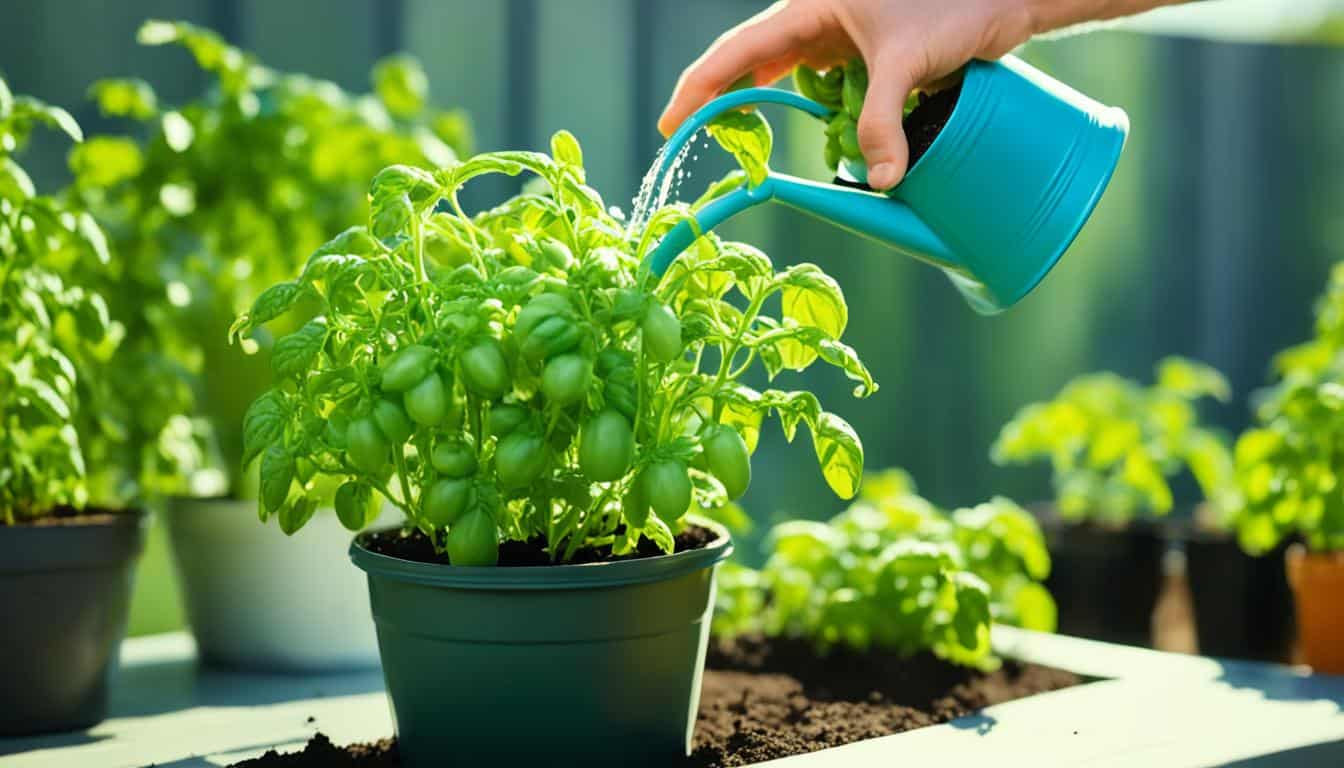
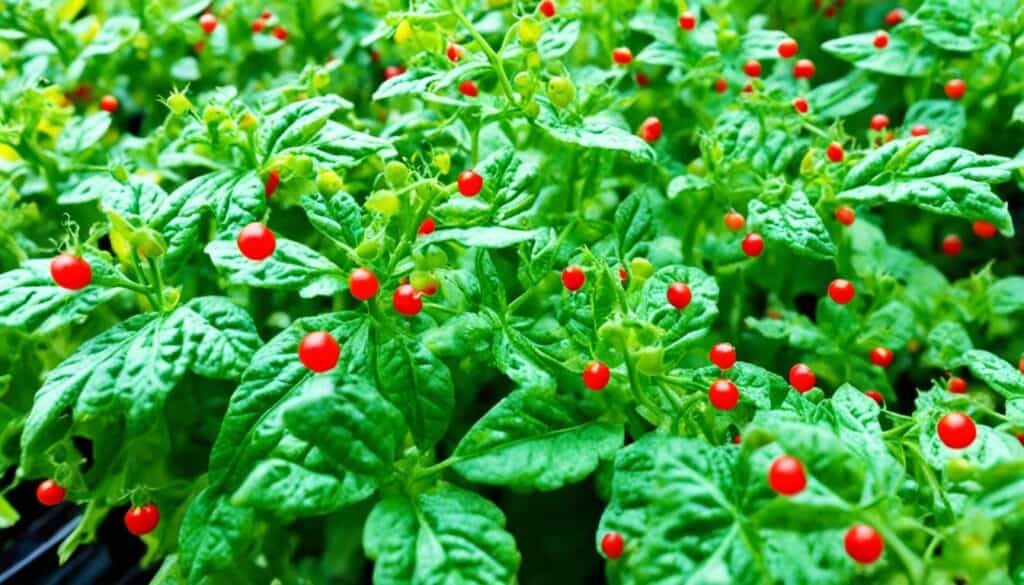
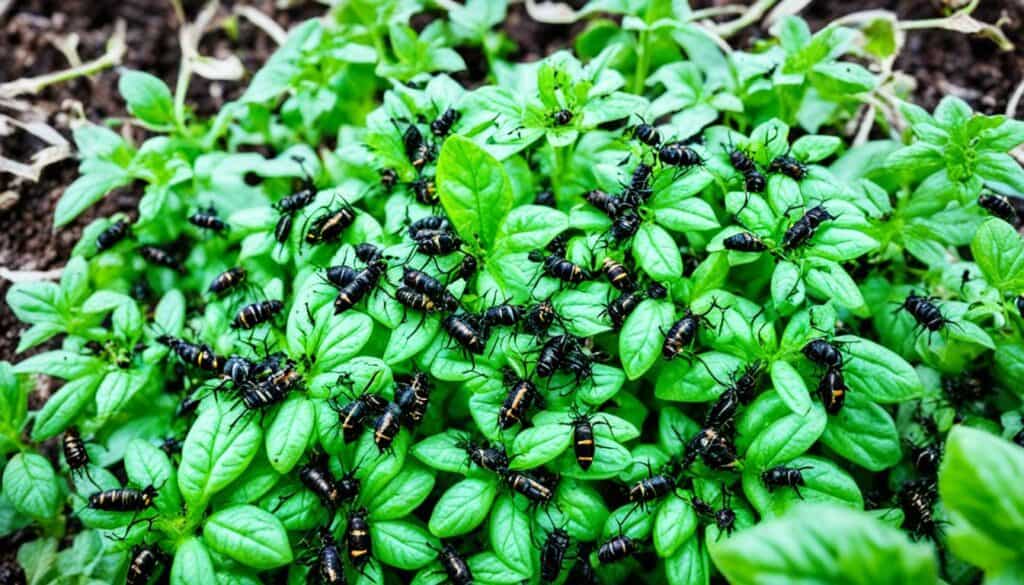
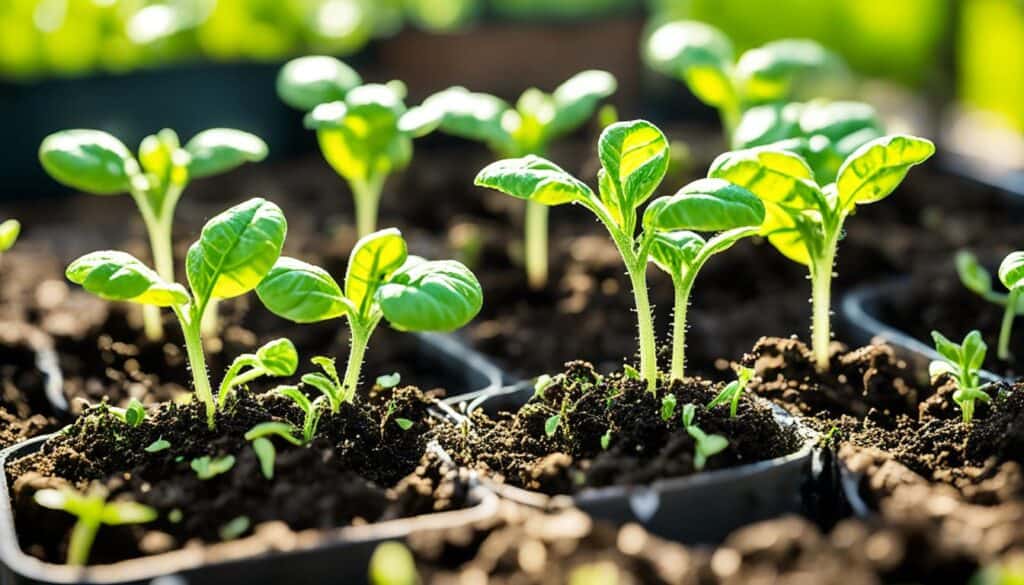
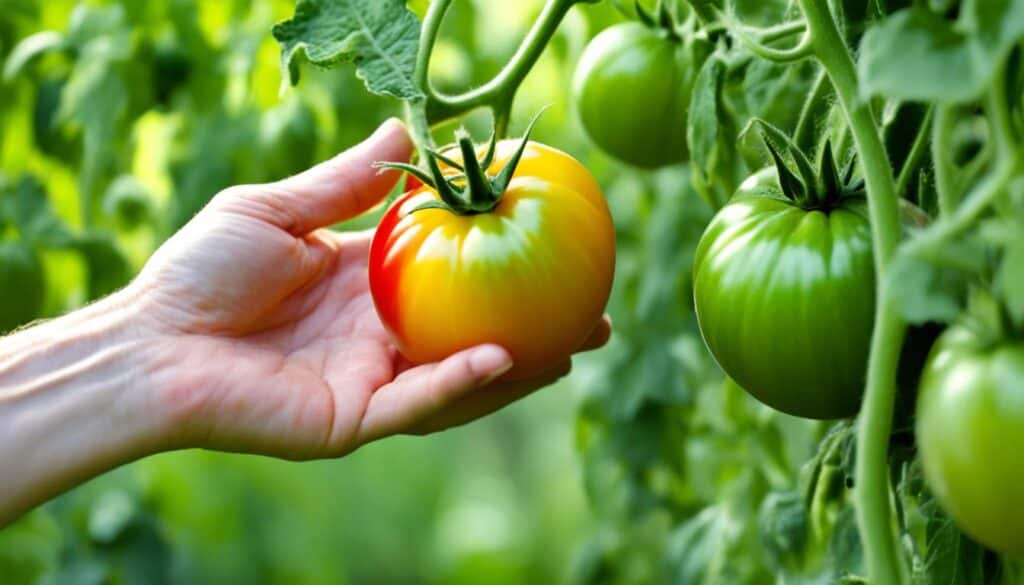
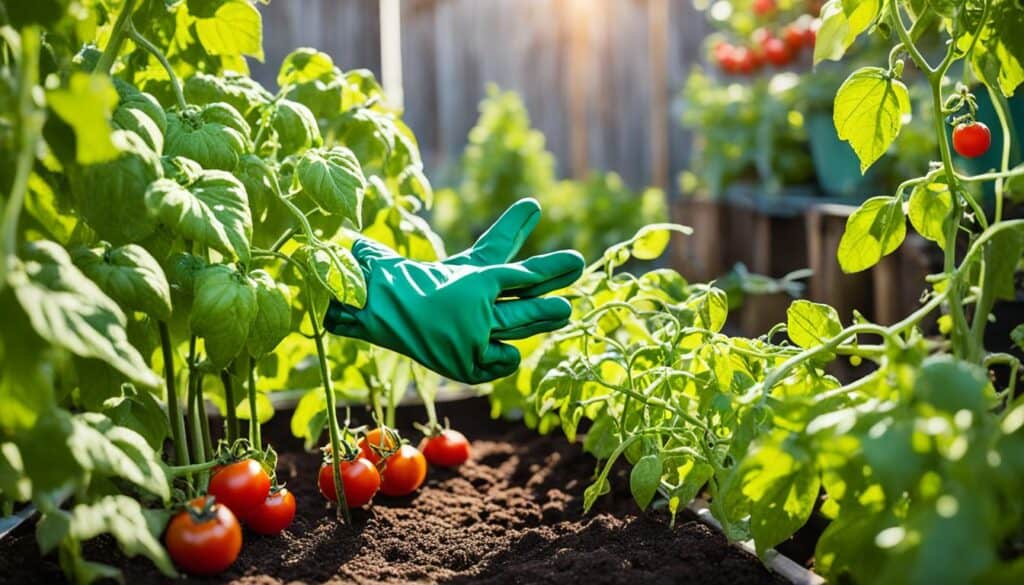

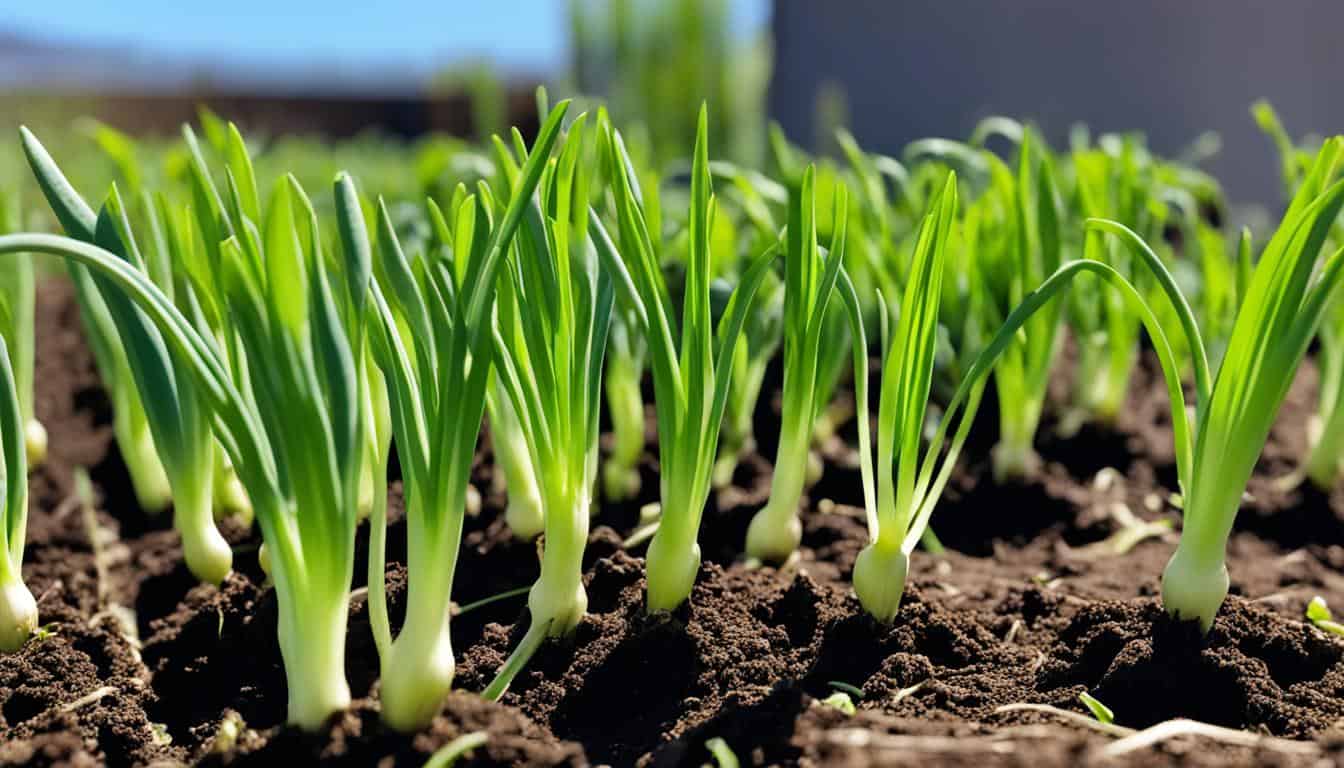

Leave a Reply